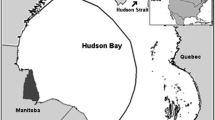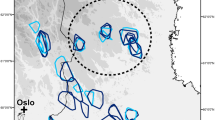Abstract
Habitat selection studies conducted at the population scale commonly aim to describe general patterns that could improve our understanding of the limiting factors in species–habitat relationships. Researchers often consider interindividual variation in selection patterns to control for its effects and avoid pseudoreplication by using mixed-effect models that include individuals as random factors. Here, we highlight common pitfalls and possible misinterpretations of this strategy by describing habitat selection of 21 black bears Ursus americanus. We used Bayesian mixed-effect models and compared results obtained when using random intercept (i.e., population level) versus calculating individual coefficients for each independent variable (i.e., individual level). We then related interindividual variability to individual characteristics (i.e., age, sex, reproductive status, body condition) in a multivariate analysis. The assumption of comparable behavior among individuals was verified only in 40% of the cases in our seasonal best models. Indeed, we found strong and opposite responses among sampled bears and individual coefficients were linked to individual characteristics. For some covariates, contrasted responses canceled each other out at the population level. In other cases, interindividual variability was concealed by the composition of our sample, with the majority of the bears (e.g., old individuals and bears in good physical condition) driving the population response (e.g., selection of young forest cuts). Our results stress the need to consider interindividual variability to avoid misinterpretation and uninformative results, especially for a flexible and opportunistic species. This study helps to identify some ecological drivers of interindividual variability in bear habitat selection patterns.




Similar content being viewed by others
References
Adriaenssens B, Johnsson JI (2013) Natural selection, plasticity and the emergence of a behavioural syndrome in the wild. Ecol Lett 16:47–55. doi:10.1111/ele.12011
Angeloni L, Schlaepfer MA, Lawler JJ, Crooks KR (2008) A reassessment of the interface between conservation and behaviour. Anim Behav 75:731–737. doi:10.1016/j.anbehav.2007.08.007
Bastille-Rousseau G, Fortin D, Dussault C, Courtois R, Ouellet J-P (2011) Foraging strategies by omnivores: are black bears actively searching for ungulate neonates or are they simply opportunistic predators? Ecography 34:588–596. doi:10.1111/j.1600-0587.2010.06517.x
Benson JF, Mahoney PJ, Patterson BR (2015) Spatiotemporal variation in selection of roads influences mortality risk for canids in an unprotected landscape. Oikos 124:1664–1673. doi:10.1111/oik.01883
Bergmüller R, Taborsky M (2010) Animal personality due to social niche specialisation. Trends Ecol Evol 25:504–511. doi:10.1016/j.tree.2010.06.012
Boyce MS, Vernier PR, Nielsen SE, Schmiegelow FKA (2002) Evaluating resource selection functions. Ecol Model 157:281–300. doi:10.1016/S0304-3800(02)00200-4
Careau V, Thomas D, Humphries MM, Réale D (2008) Energy metabolism and animal personality. Oikos 117:641–653. doi:10.1111/j.0030-1299.2008.16513.x
Cattet MRL, Caulkett NA, Obbard ME, Stenhouse GB (2002) A body-condition index for ursids. Can J Zool 80:1156–1161. doi:10.1139/z02-103
Chicoine C (2014) Estimation des densités d’ours noirs par CMR et génotypage des poils: améliorations et perspectives liées au suivi télémétrique GPS. MSc Thesis, Université du Québec à Rimouski, Rimouski, p 92
Courbin N, Fortin D, Dussault C, Fargeot V, Courtois R (2013) Multi-trophic resource selection function enlightens the behavioural game between wolves and their prey. J Anim Ecol 82:1062–1071 doi:10.1111/1365.2656.12093
DeCesare NJ, Hebblewhite M, Schmiegelow F, Hervieux D, McDermid GJ, Neufeld L, Bradley M, Whittington J, Smith KG, Morgantini LE, Wheatley M, Musiani M (2012) Transcending scale dependence in identifying habitat with resource selection functions. Ecol Appl 22:1068–1083. doi:10.1890/11-1610.1
Dingemanse NJ, Dochtermann NA (2013) Quantifying individual variation in behaviour: mixed-effect modelling approaches. J Anim Ecol 82:39–54. doi:10.1111/1365-2656.12013
Dingemanse NJ, Both C, Drent PJ, van Oers K, van Noordwijk AJ (2002) Repeatability and heritability of exploratory behaviour in great tits from the wild. Anim Behav 64:929–938. doi:10.1006/anbe.2002.2006
Dochtermann NA, Dingemanse NJ (2013) Behavioral syndromes as evolutionary constraints. Behav Ecol 24:806–811. doi:10.1093/beheco/art002
Duchesne T, Fortin D, Courbin N (2010) Mixed conditional logistic regression for habitat selection studies. J Anim Ecol 79:548–555. doi:10.1111/j.1365-2656.2010.01670.x
Duckworth RA (2010) Evolution of personality: developmental constraints on behavioral flexibility. Auk 127:752–758. doi:10.1525/auk.2010.127.4.752
Duckworth RA, Badyaev AV (2007) Coupling of dispersal and aggression facilitates the rapid range expansion of a passerine bird. Proc Natl Acad Sci 104:15017–15022. doi:10.1073/pnas.0706174104
Eagle TC, Pelton MR (1983) Seasonal nutrition of black bears in the Great Smoky Mountains National park. Int C Bear 5:94–101
Elowe KD, Dodge WE (1989) Factors affecting black bear reproductive success and cub survival. J Wildl Manage 53:962–968. doi:10.2307/3809596
Farley SD, Robbins CT (1995) Lactation, hibernation, and mass dynamics of American black bears and grizzly bears. Can J Zool 73:2216–2222. doi:10.1139/z95-262
Feil R, Fraga MF (2012) Epigenetics and the environment: emerging patterns and implications. Nat Rev Genet 13:97–109. doi:10.1038/nrg3142
Fieberg J, Matthiopoulos J, Hebblewhite M, Boyce MS, Frair JL (2010) Correlation and studies of habitat selection: problem, red herring or opportunity? Phil Trans R Soc B 365:2233–2244. doi:10.1098/rstb.2010.0079
Fortin D, Morris DW, McLoughlin PD (2008) Habitat selection and the evolution of specialists in heterogeneous environments. Isr J Ecol Evol 54:311–328. doi:10.1560/IJEE.54.3-4.311
Gillies CS, Hebblewhite M, Nielsen SE, Krawchuk MA, Aldridge CL, Frair JL, Saher DJ, Stevens CE, Jerde CL (2006) Application of random effects to the study of resource selection by animals. J Anim Ecol 75:887–898. doi:10.1111/j.1365-2656.2006.01106.x
Graham MH (2003) Confronting multicollinearity in ecological multiple regression. Ecology 84:2809–2815. doi:10.1890/02-3114
Hadfield JD (2010) MCMC methods for multi-response generalized linear mixed models: the MCMCglmm R package. J Stat Softw 33:1–22
Hadfield JD, Wilson AJ, Garant D, Sheldon BC, Kruuk LEB (2010) The Misuse of BLUP in ecology and evolution. Am Nat 175:116–125. doi:10.1086/648604
Hebblewhite M, Merrill E (2008) Modelling wildlife–human relationships for social species with mixed-effects resource selection models. J Appl Ecol 45:834–844. doi:10.1111/j.1365-2664.2008.01466.x
Hooten MB, Hobbs NT (2015) A guide to Bayesian model selection for ecologists. Ecol Monogr 85:3–28. doi:10.1890/14-0661.1
Jaenike J, Holt RD (1991) Genetic variation for habitat preference: evidence and explanations. Am Nat 137:S67–S90
Johnson DH (1980) The comparison of usage and availability measurements for evaluating resource preference. Ecology 61:65–71. doi:10.2307/1937156
Johnson JC, Sih A (2007) Fear, food, sex and parental care: a syndrome of boldness in the fishing spider, Dolomedes triton. Anim Behav 74:1131–1138. doi:10.1016/j.anbehav.2007.02.006
Klar N, Fernández N, Kramer-Schadt S, Herrmann M, Trinzen M, Büttner I, Niemitz C (2008) Habitat selection models for European wildcat conservation. Biol Cons 141:308–319. doi:10.1016/j.biocon.2007.10.004
Koper N, Manseau M (2009) Generalized estimating equations and generalized linear mixed-effects models for modelling resource selection. J Appl Ecol 46:590–599. doi:10.1111/j.1365-2664.2009.01642.x
Latham ADM, Latham MC, Boyce MS (2011) Habitat selection and spatial relationships of black bears (Ursus americanus) with woodland caribou (Rangifer tarandus caribou) in northeastern Alberta. Can J Zool 89:267–277. doi:10.1139/z10-115
Leclerc M, Vander Wal E, Zedrosser A, Swenson JE, Kindberg J, Pelletier F (2015) Quantifying consistent individual differences in habitat selection. Oecologia. doi:10.1007/s00442-015-3500-6
LeCount AL (1987) Causes of black bear cub mortality. Bears: Biol Manage 7:75–82. doi:10.2307/3872610
Lesmerises R, Rebouillat L, Dussault C, St-Laurent M-H (2015) Linking GPS telemetry surveys and scat analyses helps explain variability in black bear foraging strategies. PLoS ONE 10:e0129857. doi:10.1371/journal.pone.0129857
Łomnicki A (1999) Individual-based models and the individual-based approach to population ecology. Ecol Model 115:191–198. doi:10.1016/S0304-3800(98)00192-6
Manly BFJ, McDonald LL, Thomas DL, McDonald TL, Erickson WP (2002) Resource selection by animals: statistical design and analysis for field studies, 2nd edn. Kluwer Academic Publishers, Dordrecht
Mitchell MS, Powell RA (2003) Response of black bears to forest management in the southern Appalachian Mountains. J Wildl Manage 67:692–705. doi:10.2307/3802676
Mohr CO (1947) Table of equivalent populations of North American small mammals. Am Midl Nat 37:223–249. doi:10.2307/2421652
Morris DW (2003) How can we apply theories of habitat selection to wildlife conservation and management? Wildl Res 30:303–319. doi:10.1071/WR02028
Mosnier A, Ouellet J-P, Courtois R (2008) Black bear adaptation to low productivity in the boreal forest. Ecoscience 15:485–497. doi:10.2980/15-4-3100
Nielsen SE, Shafer ABA, Boyce MS, Stenhouse GB (2013) Does learning or instinct shape habitat selection? PLoS ONE 8(1):e53721. doi:10.1371/journal.pone.0053721
Northrup JM, Anderson CR Jr, Wittemyer G (2015) Quantifying spatial habitat loss from hydrocarbon development through assessing habitat selection patterns of mule deer. Glob Change Biol 21:3961–3970
Noyce KV, Kannowski PB, Riggs MR (1997) Black bears as ant-eaters: seasonal associations between bear myrmecophagy and ant ecology in north-central Minnesota. Can J Zool 75:1671–1686. doi:10.1139/z97-794
Økland RH (1999) On the variation explained by ordination and constrained ordination axes. J Veg Sci 10:131–136. doi:10.2307/3237168
Oksanen J, Blanchet FG, Kindt R, Legendre P, Minchin PR, O’Hara RB, Simpson GL, Solymos P, Stevens MHH, Wagner H (2013) Package “vegan.” Community Ecol Package Version 2
Orians GH, Wittenberger JF (1991) Spatial and temporal scales in habitat selection. Am Nat 137:S29–S49
Powell RA, Zimmerman JW, Seaman DE (1997) Ecology and behaviour of North American black bears: home ranges, habitat, and social organization. Chapman & Hall, London
Prokopenko CM, Boyce MS, Avgar T (2017) Characterizing wildlife behavioural responses to roads using integrated step selection analysis. J Appl Ecol (early view). doi:10.1111/1365-2664.12768
Pruitt JN, Riechert SE (2009) Sex matters: sexually dimorphic fitness consequences of a behavioural syndrome. Anim Behav 78:175–181. doi:10.1016/j.anbehav.2009.04.016
R Development Core Team (2013) R: a language and environment for statistical computing. R foundation for statistical computing, Austria
Rogers LL (1987) Effects of food supply and kinship on social behavior, movements, and population growth of black bears in northeastern Minnesota. Wildl Monogr 97:3–72
Rosenzweig ML (1981) A theory of habitat selection. Ecology 62:327–335
Rosenzweig ML (1991) Habitat selection and population interactions: the search for mechanism. Am Nat 137:S5–S28
Sih A, Bell A, Johnson JC (2004) Behavioral syndromes: an ecological and evolutionary overview. Trends Ecol Evol 19:372–378. doi:10.1016/j.tree.2004.04.009
Sih A, Cote J, Evans M, Fogarty S, Pruitt J (2012) Ecological implications of behavioural syndromes. Ecol Lett 15:278–289. doi:10.1111/j.1461-0248.2011.01731.x
Smith BR, Blumstein DT (2008) Fitness consequences of personality: a meta-analysis. Behav Ecol 19:448–455. doi:10.1093/beheco/arm144
Smith BR, Blumstein DT (2010) Behavioral types as predictors of survival in Trinidadian guppies (Poecilia reticulata). Behav Ecol 21:919–926. doi:10.1093/beheco/arq084
Spiegelhalter DJ, Best NG, Carlin BP, Van Der Linde A (2002) Bayesian measures of model complexity and fit. J R Stat Soc Stat Methodol 64:583–639. doi:10.1111/1467-9868.00353
Sweeney K, Gadd RDH, Hess ZL, McDermott DR, MacDonald L, Cotter P, Armagost F, Chen JZ, Berning AW, DiRienzo N, Pruitt JN (2013) Assessing the effects of rearing environment, natural selection, and developmental stage on the emergence of a behavioral syndrome. Ethology 119:436–447. doi:10.1111/eth.12081
Wolf M, Weissing FJ (2012) Animal personalities: consequences for ecology and evolution. Trends Ecol Evol 27:452–461. doi:10.1016/j.tree.2012.05.001
Young DD, Beecham JJ (1986) Black bear habitat use at Priest Lake, Idaho. Int C Bear 6:73–80. doi:10.2307/3872808
Acknowledgements
We thank C. Dussault, S. Gravel, D. Grenier, C. Harvey and G. Lupien for bear captures, as well as A. Bérubé-Deschênes, K. Bédard, N. Bradette, C. Chicoine, J. Fillion, M. Leclerc, J.-P. Marcoux, M. Serra-David and F. Taillefer for their assistance in the field. We also thank A. Caron for statistical advice, and D. Beauchesne, J. Martin, P. Legagneux, K. Malcolm, P. and M. Fast and three anonymous reviewers for useful comments on earlier versions of the manuscript.
Author information
Authors and Affiliations
Contributions
Conceived and designed the experiments: R.L. M.H.S.L. Performed the experiments: R.L. MHSL. Analyzed the data: R.L. Contributed reagents/materials/analysis tools: M.H.S.L. Wrote the paper: R.L., M.H.S.L. Coordinated the funding of the project: M.H.S.L. Prepared, validated and submitted the capture protocol to the Canadian Council on Animal Care: M.H.S.L.
Corresponding author
Ethics declarations
Ethical approval
Black bear captures were conducted by the technicians of the Ministère des Forêts, de la Faune et des Parcs du Québec (hereafter MFFP) in June and July 2011 and 2012. All manipulations were approved by the Animal Welfare Committees of the MFFP and of the Université du Québec à Rimouski (certificate #2011-30).
Funding
This project was funded by the Fonds de recherche du Québec—Nature et technologies and the Fonds de recherche forestière du Saguenay–Lac-St-Jean (Grant #2011-FS-141452 to M.-H. St-Laurent), the Natural Sciences and Engineering Research Council of Canada (Grant #386661-2010 to M.-H. St-Laurent), the Ministère des Forêts, de la Faune et des Parcs du Québec, Resolu Forest Products Inc. and the Université du Québec à Rimouski.
Conflict of interest
The authors declare that they have no conflict of interest.
Additional information
Communicated by Andreas Zedrosser.
Rights and permissions
About this article
Cite this article
Lesmerises, R., St-Laurent, MH. Not accounting for interindividual variability can mask habitat selection patterns: a case study on black bears. Oecologia 185, 415–425 (2017). https://doi.org/10.1007/s00442-017-3939-8
Received:
Accepted:
Published:
Issue Date:
DOI: https://doi.org/10.1007/s00442-017-3939-8




